Treatment of greenhouse cucumbers for diseases: photo and description
Aspiring gardeners think that greenhouse plants don't need protection from diseases and pests. However, this is not so - cucumbers in the greenhouse get sick as often as in the open field. Moreover, in a closed room, infections spread much faster. If one plant is sick in the greenhouse, the risk of infection of all plantings is higher.
In order not to lose crops due to diseases, you need to know how to prevent them. If the infection has already affected the plants, it is important to timely identify the disease and promptly take therapeutic and protective measures.
In our article - everything about diseases of cucumbers in a greenhouse and their treatment: photos, descriptions, symptoms, causes and methods of prevention.
The content of the article
Description and symptoms of cucumber diseases
To cure a disease, it is important to define it correctly.... There are viral, fungal and bacterial infections that affect plants. The fight against them has its own nuances.
Fungal
Fungal infections of plants become infected through soil, gardening tools, planting material or from other affected crops. The development of such diseases begins from the site of the lesion, gradually spreads throughout the bush.
Fungal infections in most cases are treatable... Plants in a greenhouse are most often affected by them in case of violation of the rules of care or adverse weather conditions.
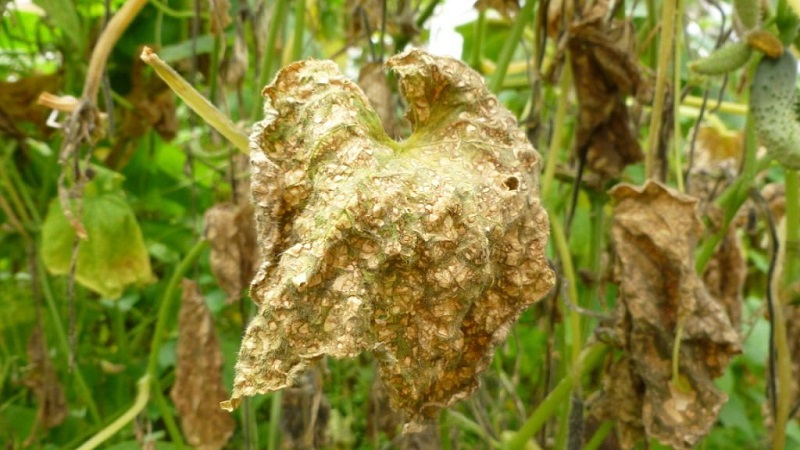
Types of fungal diseases:
- White rot... Most often it affects greenhouse cucumbers. The leaves and stems of plants are covered with a white wet bloom, which leads to their rotting. The fruits start to rot, look frostbitten and have a strong putrid odor. Plants gradually die.
- Gray rot... “Velvet” light gray spots appear on the ground part of the bush. They spread quickly throughout the plant and healthy plantings.
- Root rot... The fungus affects the roots and root collar of plants. Because of this, the leaves turn yellow and dry. The root part rots, becomes thinner, which leads to the breaking off of the stem.
- Ascochitosis... The disease is also called black rot (pictured above). Brown spots appear on the inside of the leaves of the affected cucumbers, which gradually turn black. In some cases, the fungus spreads to the leaves.
- Powdery mildew... A fungal disease that spreads rapidly across all plantings. Its symptoms are white plaques on the leaves that lead to wilting.
- Downy mildew... Dull light yellow spots appear on the leaves and stems of cucumbers, gradually merging into large areas of the lesion. This leads to the death of plants.
- Anthracnose... The leaf plates are covered with tubercles, which soon turn into holes. The fruits become lethargic, rotten depressions appear on them.
If there was an epidemic of fungal diseases in the greenhouse, then the pathogen will remain in the ground for several years. Experienced farmers recommend replacing the top layer of contaminated soil with new soil.
Bacterial
Bacteriosis also called "angular spotting" for the fact that the ground part of the affected cucumbers is covered with triangular or polygonal dark spots.
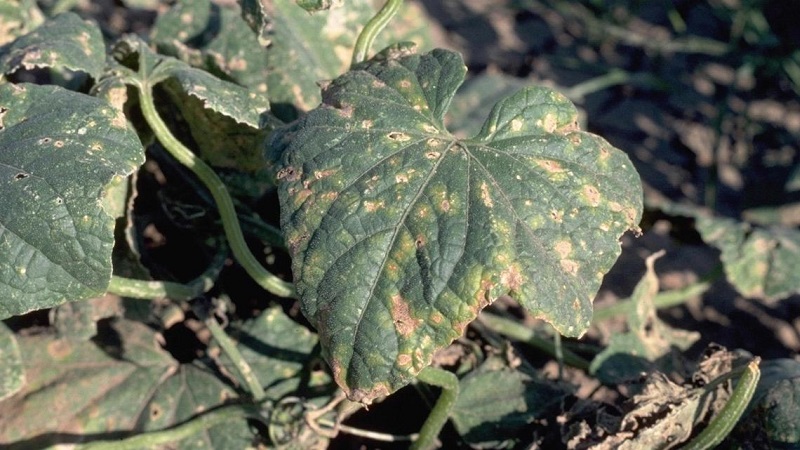
With such a disease dry voids form inside the fruit... The rest of the cucumber often starts to rot.
it the disease is not cured and quickly attacks healthy plants... To save unaffected plantings, diseased specimens are removed by the roots from the beds and destroyed.
Viral
Viral diseases considered the most dangerous: they are not treatable... Therefore, prevention plays an important role.
Attention! Most often, viral infections are spread by insects.
Viral diseases of cucumbers:
- Green mosaic... The leaf plate of the affected plants becomes covered with light green spots, shrivels and withers. Lumpy colored formations appear on the fruits. The plant ceases to form ovaries and inflorescences.
- White mosaic... The leaves are covered with acute-angled white and yellow spots. The fruits acquire a striped white-yellow color.
- Cucumber viral necrosis... The greenery of the plant turns purple and becomes covered with brown spots. Inflorescences and lashes die off, but new ones are not formed. This leads to the death of the culture.
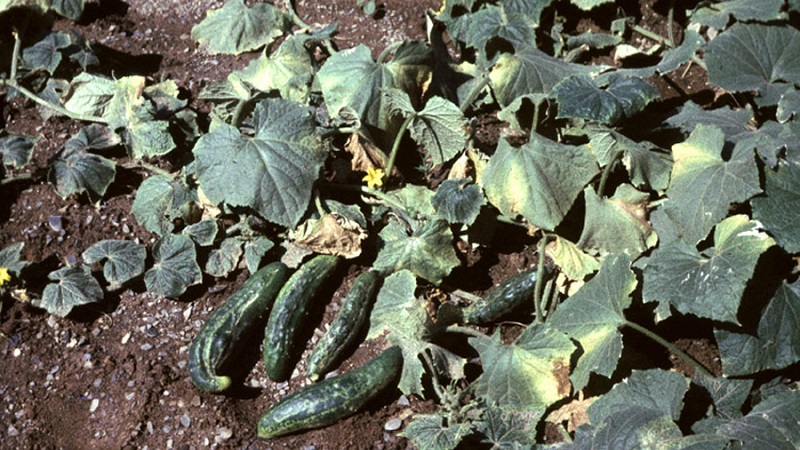
Distinguishing diseases from pest problems
Plants change their appearance not only due to disease. Often gardeners confuse traces of pests with diseases:
- Spider mite... The pest sucks sap from the plants, which causes the leaves to dry. The bushes are covered with cobwebs.
- Aphid... Leaves and stems become pale and lethargic. The ovaries fall off, but new ones are not formed. On the back of the leaf plate and stems, small light green midges are found.
- Greenhouse whitefly. Insect caterpillars suck the juices from the plant, which leads to its death. The insect feels good in high humidity conditions. A whitefly can be recognized by the presence of caterpillars and moth-like butterflies.
The reasons for the development of diseases
What to do if cucumbers disappear in the greenhouse? Most often, plants in greenhouses and greenhouses get sick due to mistakes in agricultural technology.... Less often unfavorable weather conditions have an effect.
Why do cucumbers in a greenhouse get sick?:
 contaminated soil - diseases occur if the plants that grew earlier in the greenhouse were infected with infections or the soil was not disinfected before planting;
contaminated soil - diseases occur if the plants that grew earlier in the greenhouse were infected with infections or the soil was not disinfected before planting;- contaminated fertilizers - compost, humus and manure may contain pathogens;
- infection on materials - pathogens often get on plants from garden tools or from planting material;
- violation of the rules of watering - the development of fungal diseases is promoted by both high and low humidity, condensation in the room;
- incorrect pinching - if you water cucumbers immediately after pinching, it will be easier for fungal spores to penetrate into the "wounds";
- lack of micronutrients - the immunity of cucumbers decreases, and they become more susceptible to diseases;
- pests - carry viral infections.
Treatments for cucumber diseases
Before processing cucumbers for diseases in the greenhouse, it is worth choose the appropriate type of product:
- Folk... Assumes the use of household (often food) products. This option is safe.
- Chemical... Special remedies for plant diseases, sold in gardening stores, are considered the most effective. The disadvantage is that such drugs can accumulate in the fruit.
- Biological... Available from specialty stores. Safer than chemical.
- Pharmacy... Some medicines are suitable not only for treating people, but also for fighting plant diseases. They are considered to be effective and safe.
Viral diseases cannot be treated. To save the planting, the infected plants are completely removed.
With a fungal infection only the affected parts are removed. The rest of the bush can be saved with antifungal treatment.
Chemical
Experienced gardeners recommend using chemicals when homemade recipes no longer help. Such funds reduce the ecological purity of cucumbers, but save the harvest.
Most effective chemicals:
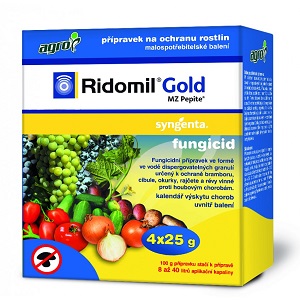 "Quadris"... It belongs to the group of strobilurins. Effective against downy mildew and powdery mildew, spots, rot, etc. Completely kills fungal diseases. Harmful to people - they work with him only in protective masks.
"Quadris"... It belongs to the group of strobilurins. Effective against downy mildew and powdery mildew, spots, rot, etc. Completely kills fungal diseases. Harmful to people - they work with him only in protective masks.- Ridomil Gold... One of the most effective antifungal drugs. Contains components that work inside and out.
- Thanos... Effective against rot, downy mildew. It is considered the most effective way to combat Alternaria. Forms a film on the ground part of the bush that is not washed off with water. The drug penetrates the fungus and provokes irreversible changes in it. The infection does not develop resistance to this drug.
These drugs help against fungal diseases. They are aboutespecially effective in the early stages of disease development.
By such means plants are sprayed no more than once a week... It is not recommended to use them after the formation of ovaries.
Note! Fungi often develop immunity to drugs acting inside the plant. Products that protect the outside of the cucumber are less likely to cause resistance.
Biological
Biological drugs are sold in gardening stores... They are effective in fighting cucumber diseases and are safer than chemicals.
Description of different types of funds:
 Fungal... They are made on the basis of fungi that penetrate the mycelium of the infection, destroying it. Effective against rot, powdery mildew, verticillium. They differ in a short shelf life and storage requirements. These funds include "Trichodermin".
Fungal... They are made on the basis of fungi that penetrate the mycelium of the infection, destroying it. Effective against rot, powdery mildew, verticillium. They differ in a short shelf life and storage requirements. These funds include "Trichodermin".- Bacterial... Protect against diseases and pests. They are used for watering and spraying. Natural antibiotics are isolated. These drugs include "Baktofit" and "Fitosporin".
- Plant extracts... Protect against diseases and pests, increase plant productivity. Approximate in action to folk remedies.
Biological preparations not only help fight diseases, but also strengthen the immunity of plants. Unlike chemical fungicides, they do not accumulate in cucumbers.
Pharmacy
Pharmacy products are used not only to treat people and animals, but also to combat plant diseases. Such agents have a pronounced antifungal and antimicrobial effect. They considered to be quite effective:
- Iodine... A drug with a pronounced antifungal effect. It is useful for the prevention and treatment of diseases, strengthening the immune system, improving the quality of vegetation. To prepare the medicine, 10 drops are added to 10 liters of water. Cucumbers are sprayed with this composition, consuming up to 1 liter per square meter.
- Brilliant green ("Brilliant green"). Effective against powdery and downy mildew. To prepare the drug for 10 liters of water, take half a bottle of "brilliant green". The product is sprayed on the ground part of the cucumbers.
 "Metronidazole"... For every 10 liters of water, take 20 crushed tablets for adult plants and 10 tablets for seedlings. The resulting composition is sprayed with cucumbers immediately after cooking.
"Metronidazole"... For every 10 liters of water, take 20 crushed tablets for adult plants and 10 tablets for seedlings. The resulting composition is sprayed with cucumbers immediately after cooking.- "Aspirin" helps from rot. To prepare the medicine, 2 crushed tablets are dissolved in 10 liters of water. The drug is used for spraying.
- Potassium permanganate... It is used for disinfection of soil (dark pink solution) and planting material (light pink solution). A light pink solution of potassium permanganate is sprayed on adult plants during an epidemic for prevention.
- Hydrogen peroxide... Used to disinfect seeds. The planting material is soaked in liquid for a quarter of an hour.
- "Nystatin"... Effective against all types of fungal diseases. For every 1 liter of water, take 1 tablet. The agent is sprayed on cucumbers for treatment and prevention during epidemics.
Folk
Folk remedies are considered the safest. They are good for the prevention and treatment of diseases in the early stages of development.
The most popular ones:
- Ash... A versatile product that is used for fertilizing, treatment and pest control. A glass of ash and a bar of soap are added to a bucket of water, and the leaves are sprayed with the resulting product once a week.
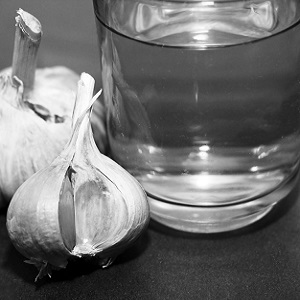 Garlic solution... Helps with fungi. A head of minced garlic is added to a liter jar of water. The mixture is infused for 2 weeks in a dark place. The composition is diluted in 10 liters of water.
Garlic solution... Helps with fungi. A head of minced garlic is added to a liter jar of water. The mixture is infused for 2 weeks in a dark place. The composition is diluted in 10 liters of water.- Garlic, oil and soap... Two heads of garlic, 0.5 l of vegetable oil and 60 g of liquid soap are mixed. The tool is infused for two days and diluted with water. This amount is enough to prepare 20 liters of medicine.
- Serum... Has antifungal effect. 1.5 l of whey is poured into a bucket of water. The solution is used for spraying.
- Soda ash with soap. 40 g of soda and a bar of laundry soap are added to 10 liters of water.
Disease prevention
When plants start to get sick, even chemical agents do not always help preserve the crop. To prevent the development of infection, it is recommended to follow the rules of prevention:
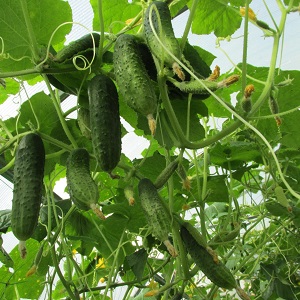 Compliance with crop rotation... Cucumbers have not been planted in the same greenhouse for more than three years in a row. If you have to constantly plant a crop in the same greenhouse, then replace the top layer of soil.
Compliance with crop rotation... Cucumbers have not been planted in the same greenhouse for more than three years in a row. If you have to constantly plant a crop in the same greenhouse, then replace the top layer of soil.- Disinfection... Disinfectants are used to treat soil, planting material, containers for seedlings, garden tools.
- Compliance with watering rules... The soil should not be overdried or waterlogged. Cucumbers watered in the greenhouse 1-2 times a week.
- Compliance with the rules of pinching... Plants are stepchild in the morning or at sunset.
- Preventive treatments... Plants are sprayed during cold snaps and epidemics with folk remedies.
- Insect protection... To do this, mosquito nets are placed on the windows of the greenhouse.
- No drafts... Cucumbers are afraid of drafts. In a greenhouse with this crop, only one window is opened.
Conclusion
Plant diseases are the most common cause of crop loss. They can overtake even an experienced gardener. Compliance with the rules of prevention significantly reduces the likelihood of this problem. If the cucumbers are still infected by an infection, choose the safest plant remedies.